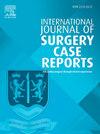A successful surgical management of spinal cord herniation in a patient with old thoracic spine fracture: a case report from Syria
IF 0.6
Q4 SURGERY
引用次数: 0
Abstract
Introduction
Idiopathic spinal cord herniation is a very uncommon condition marked by the spinal cord protruding through a defect in the front part of the dura mater. Because there is limited clinical evidence available, the treatment options and outcomes for idiopathic spinal cord herniation remain unclear. We report this first case of idiopathic spinal cord herniation at the T5 level in Syria.
Case presentation
A 31-year-old Syrian man presented with a 4-year history of numbness and weakness in the right lower limb. Magnetic resonance imaging (MRI) revealed that his spinal cord was displaced ventrally at the T5 level. A surgical procedure was performed through a posterior midline approach. During the operation, a tear in the ventral dura was discovered. After the herniated tissue was repositioned, the defect was closed with sutures. After a 3-month follow-up, the lower-extremity weakness was improved, and there was no recurrence. The patient remained stable after nine months.
Discussion
Spinal cord herniation is a rare and challenging condition for medical practitioners because it is poorly understood. Several pathological mechanisms have been proposed, yet the term “idiopathic spinal cord herniation” remains the most common. Trauma and mechanical mechanisms are more convincing and generally accepted.
Conclusion
Surgery's main goal is to prevent the worsening of the condition, we identify trauma as a key cause and highlight suture therapy as an effective treatment. More studies are needed to clarify the pathology and treatment options for this disease.
成功的手术治疗脊髓突出的病人,老年性胸椎骨折:一个病例报告,来自叙利亚
特发性脊髓疝是一种非常罕见的疾病,其特征是脊髓通过硬脑膜前部的缺损突出。由于现有的临床证据有限,特发性脊髓疝的治疗方案和结果仍不清楚。我们报告这第一例特发性脊髓疝在叙利亚的T5水平。病例介绍:一名31岁叙利亚男子,右下肢麻木无力病史4年。磁共振成像(MRI)显示他的脊髓在T5水平腹侧移位。手术通过后路中线入路进行。术中发现腹侧硬脑膜撕裂。将突出组织重新定位后,用缝线缝合缺损。随访3个月,下肢无力得到改善,无复发。9个月后病人病情保持稳定。脊髓疝是一种罕见且具有挑战性的疾病,因为对其了解甚少。已经提出了几种病理机制,但术语“特发性脊髓疝”仍然是最常见的。创伤和机械机制更有说服力,并被普遍接受。结论外科手术的主要目的是防止病情恶化,我们认为创伤是主要原因,强调缝合治疗是有效的治疗方法。需要更多的研究来阐明这种疾病的病理和治疗方案。
本文章由计算机程序翻译,如有差异,请以英文原文为准。
求助全文
约1分钟内获得全文
求助全文
来源期刊
CiteScore
1.10
自引率
0.00%
发文量
1116
审稿时长
46 days

 求助内容:
求助内容: 应助结果提醒方式:
应助结果提醒方式:


